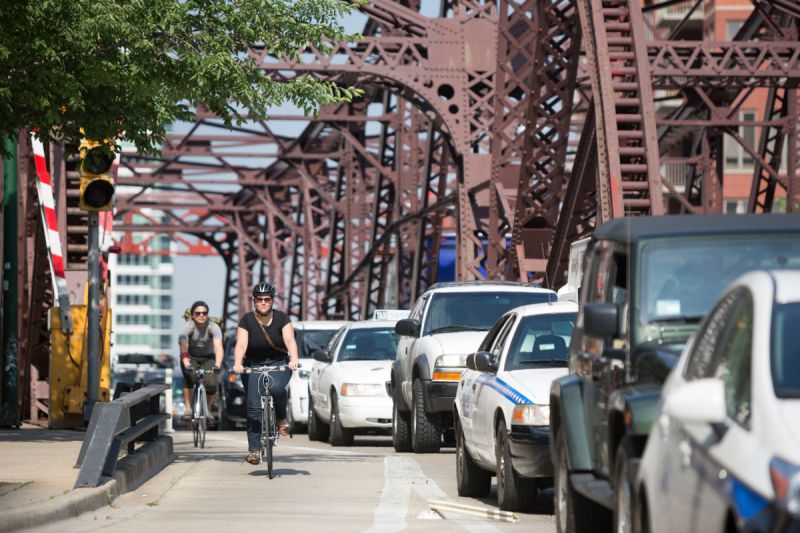The handful of cities that led the rebound of U.S. bike commuting a decade ago seem to have slowed down — but continuing growth elsewhere suggests that progress can still happen if cities want it to.
According to Census estimates released Thursday, the total number of U.S. bike commuters fell slightly in 2016 for the second year in a row, to 863,979. That's far enough beyond the margins of error to all but guarantee that U.S. bike commuting has slipped since global gas prices plummeted in late 2014.
In 2016, the national average gas price was $2.25 a gallon, down 35 percent since 2014.
In New York City, 1.2 percent of commuters said they usually take a bike most of the way to work, extending a three-year plateau. In Chicago, the estimate was 1.7 percent, the same as in 2014. In Los Angeles: 1.1 percent, statistically flat but the lowest estimate since 2012. Philadelphia again posted 2.2 percent, a rate it first hit in 2009.
The estimates in Minneapolis, Portland, Seattle and San Francisco all ticked downward, though as in the larger cities, their longer-term trends also continue to suggest gradual growth.

Even Davis, California, one of the country's longtime leaders in bicycle mode share, saw its third straight year of falling estimates in the Census Bureau's American Community Survey. The university town estimated 17 percent of trips by bike, down from 25 percent in 2013.
Here's a full report on the latest one-year estimates for every place the Census attempts to track bike commuting.
Despite national headwind, some cities make gains

Penn Avenue, Pittsburgh.
A few cities seemed to buck the trend. Pittsburgh, Washington, Detroit, and Cleveland posted all-time highs.
"Since bike lanes have been installed in Pittsburgh, we've more than doubled that ACS number," said Eric Boerer, advocacy director for BikePGH, in an interview. "You can see a pretty sharp rise after 2007."
Pittsburgh was estimated at 0.4 percent bike commuting in 2000, 1.1 percent in 2007 and now — as of this morning — 2.6 percent.

"The city has been taking transportation much more seriously than ever," Boerer said. "For every aspect, from design to building to even marketing, they've been doing a much better job."
Just this week, Boerer said, a project on Negley Avenue will close a key gap in Pittsburgh's biking network.
"A lot of the bike infrastructure on one side of the city doesn't connect to the bike infrastructure on the other side of the city," he said. "And Negley will connect. That's going from a fast-moving four-lane street to two lanes with bike lanes."
Top researcher: Biking still has lots of room to grow, if cities want it to

Tucson, Arizona.
Ralph Buehler, a professor of urban affairs at Virginia Tech and a leading scholar of bike transportation, noted that "one year alone is not a full trend," due to normal survey error.
But he said a small retreat in biking rates seems plausible.
"It's interesting that almost all large cities seem to be going down, which you wouldn't expect from pure statistical variability," he said. "It fits with other data: We have surpassed the pre-recession levels of VMT, so people are driving more. There's some stories in the Census data that the suburbs are growing faster again than cities. So it fits into this overall picture that seems to be emerging."
Buehler said the lower cost of driving, rising median incomes, and maybe even declining safety could be contributing to the ebb.
"If you think about a choice rider," Buehler said, "they have to have a very positive and safe experience cycling. Otherwise they will choose the other mode."
We asked Buehler if he thought the slowdown among leading cities suggests that bike commuting has reached a natural plateau in those places, with little room left to grow.
He doesn't think so.
"I think there is a plateau somewhere for cycling, but just given all the data we have about distances and all these things, a lot more trips could be covered by bicycle," he said. "But it may be harder to get at additional populations."
"To reach the next share of the population — I don't know how big that is — cycling may have to be more attractive, or feel safer or be safer," Buehler said. "I think that cities have to do more of what they did: They have to create an attractive cycling experience that feels safe and is safe."
Michael Andersen is staff writer for PlacesForBikes, a PeopleForBikes program to help U.S. communities build better biking, faster. Ken McLeod is policy director for the League of American Bicyclists, leading the movement to build a bicycle-friendly America for everyone.






